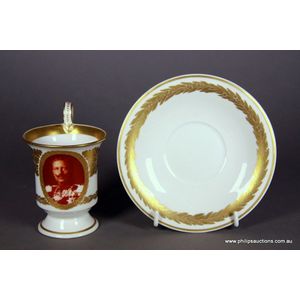Spode Pineapple Serving Stand, Circa 1825
You must be a subscriber, and be logged in to view price and dealer details.
Subscribe Now to view actual auction price for this item
When you subscribe, you have the option of setting the currency in which to display prices to $Au, $US, $NZ or Stg.
- Firing Crack - A firing crack is a crack in a porcelain or stoneware item that occurs whilst the item is in the kiln.They are usually caused by faulty design, where one part is thicker than the surrounding area, and being thicker it cools more slowly, setting up a stress with the surrounding area. Firing cracks are not often seen on modern mass produced porcelain, as the damaged items are discarded during prooduction. However they are seen in earlier items and artisan-produced objects.
- Bone China - Bone china, Also called 'English china", is one of the three types of porcelain, the other two being soft paste porcelain and hard paste porcelain.
Porcelain is an ancient ceramic material, first made in China, hence the common name "china", and the introduction of bone china was to counter the imports of Chinese porcelain.
The initial development of bone china is credited to Josiah Spode, who introduced it around 1800 and it was soon after copied by other manufacturers including Minton, Coalport, Davenport, Derby, Worcester, Wedgwood and Rockingham and the Herculaneum factory at Liverpool.
Spode's bone china was made by mixing ash from cattle bones with feldspar and kaolin, which created a material that was stronger, more translucent, and whiter than traditional porcelain. He began to produce this new type of porcelain in 1796 and it quickly became very popular.
At the time, the process and ingredients were kept secret and were only known to a few manufacturers and were protected by patents.
In the 19th century, bone china became increasingly popular and was widely produced by many manufacturers in England. During this time, it was considered a luxury item and was often used to create fine dining sets and other decorative items.
Bone china is still used in the production of fine porcelain wares, such as tea sets, figurines, and other decorative pieces. His basic formula of six parts bone ash, four parts china stone, and three and a half parts china clay remains the standard English body. It is still considered a luxury item due to its strength, translucency, and whiteness, and is often used for high-end and high-quality porcelain. China. - Pineapple - The pineapple, named because of its resemblance to a pine cone, was an exotic and scarce fruit in the 18th century. It became a popular decorative motif on furniture, silver ceramics, glass and clocks during this time.
- Circa - A Latin term meaning 'about', often used in the antique trade to give an approximate date for the piece, usually considered to be five years on either side of the circa year. Thus, circa 1900 means the piece was made about 1900, probably between 1895 and 1905. The expression is sometimes abbreviated to c.1900.
- A/f, as Inspected - The letters "A/F" or "as inspected" as part of a description is the cataloguer's shorthand for "all faults" or "as found", meaning the item has some type of damage or deficiency, it is of uncertain date or provenance, and/or that the seller takes no responsibility for the completeness of the item or the accuracy of the description.
This item has been included into following indexes:
Visually similar items

A Samson of Paris cup and saucer, circa 1890, marked underside with a 'Curvaceous X' to indicate English-style Ware, both straight sided cup and saucer with grisaille decoration of a European lakeside landscape with figures, boats and castles upon a lemon

Late 19th/early 20th Satsuma buckle plain circular painted with landscape and flags entitled 'Empress of China London'

Meissen blue and white onion pattern match striker

A KPM Paul Von Hindenburg portrait cup and saucer, circa 1900, pattern 6475, with German iron cross mark, the pedestal cup with scrolled handle having an everted rim, decorated with gilt oak leaf borders and laurel bands, with a photographic portrait of th
